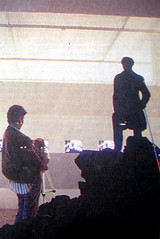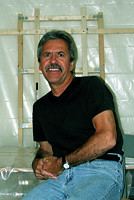FRONT AND CENTER/Susan Blocker
Front and Center
Exhibit makes passersby
A big part of the art
Susan Blocker, Wisconsin State Journal
Sunday, April 21, 1996
It’s afternoon on State Street, and people are striding past the Madison Art center.
Focused on their destination, only a few glance in the picture window of the Art Center to see the art installation inside. Even those who do glance seem not to comprehend that they have, for a fleeting moment, become a part of the art.
A camera placed inside the window is capturing the passersby and projecting their moving image into a bank of television monitors along a wall opposite the window.
“I want my viewers to have that kind of opportunity, to have that kind of contact with the work…to become part of the work and, on one hand, to finish it, said artist Daniel Smajo-Ramirez.
The installation, “Survoyeur,” has several elements. First, it is based on an 1818 painting by German Romanticist Caspar David Friedrich, “Wanderer Above the Sea of Fog.”
In the original, a man stands with his back to the viewer overlooking a misty mountain valley. Ramirez created a large black cutout of Friedrich’s figure and attached it to the window, apparently overlooking the Art Center space. He is holding a cane, which Ramirez has made red and white – like a cane used by the blind.
The floor between the window and the bank of televisions is covered with gravel, and gray rectangles are painted on the two wall of the room. The same cutout figure also is generated on the television screens.
A basic idea behind the work is to explore the ways to see and the ways to be seen. The man, for example, is both a surveyor ostensibly overlooking a mountain valley and a voyeur watching the antics of the people who are watching him.
That interaction of people with the installation has brought some surprising results, Ramirez said.
“I get some really, really, wonderfully spontaneous responses to that image,” he said. “It kind of unfolded on its own.”
First, people see the camera and televisions and realize they’re on screen – much as they would walking past a TV display at a Sears store, he said. Then they notice the black figure on the screen and assume it’s a projection from the larger figure on the Art Center window. (In fact, the figure is generated on each screen via computer.)
When they realize their image is positioned behind the black cutout on the screen, they try to “take some kind of control” over the image.
One man took out what appeared to be a razor blade and tried to rub the window to remove the black figure. Another took off his sunglasses and tried in vain to lace them over the figure. Others held up their umbrellas to shield the figure from the rain.
Inside the center, people have moved close to the camera and opened their mouths so they would appear on the television screen to be eating the figure.
For those viewers inside the center, Ramirez hoped to create a dual experience. One, with the gray rectangles and screens, conveys a sense of sterility, of the city, he said. On the other hand, “when you stood on the rock, you could feel the contrast on your feet – the feeling of the landscape.
That duality is another aspect of Ramirez’s work. He melds the very different worlds of his own minimalism and Friedrich’s romanticism.
The 19th-century romantics saw nature as a sublime, almost mystical presence. They “played with the human being relative to nature, the awesome power of nature, “ Ramirez said. “My own thoughts about that were, ‘I’m a city person. I’m kind of a concrete-and-steel kind of guy.’ That approach to nature was not something I was familiar with.”
Instead, in his early years as an artist, Ramirez turned to abstraction and minimalism.
“I was weaned on 1960’s minimalism,” he said. “On the one hand, I felt comfortable with German Romanticism, on the other, minimalism had some validity to it. I’ve always found the two a very strong part of my life, but they were two very different ideologies.”
So in “Survoyeur,” Ramirez keeps Friedrich’s figure, but replaces the landscape with that of modern technology. The idea is to take Friedrich’s romanticism, take it apart and “recontextualize” it in contemporary terms.
The sublime of the romantic landscape is not removed with the presence of cameras and television, but is redefined, he said. “Why is it only in nature that this sublime exists? Could you not have it from a television set?…I’m curious to what others feel.”
Return to Ramirez@Luz Web Site



0 Comments:
Post a Comment
<< Home